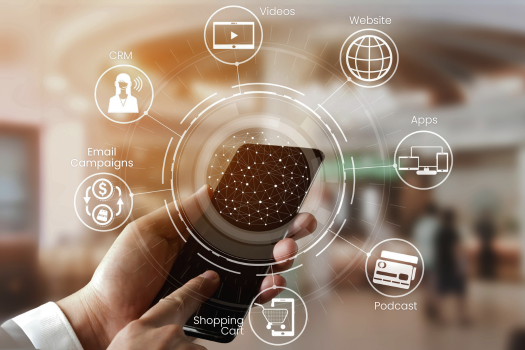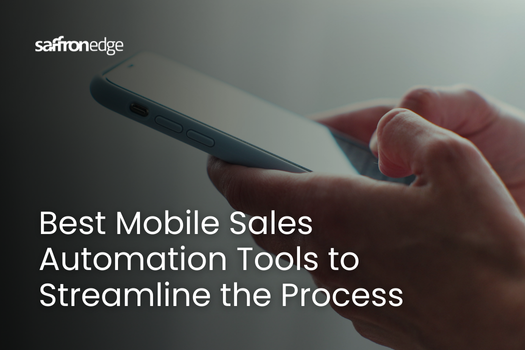Contents
- What is Omnichannel Marketing?
- The Benefits of Using an Omnichannel Approach
- What is Omnichannel Attribution?
- Creating an Omnichannel Strategy
- Steps for Leveraging Omnichannel Marketing
- Omnichannel Marketing in Brick and Mortar Stores
- Examples of Omnichannel Marketing
- Trends in Omnichannel Marketing
- Top 10 Omnichannel Marketing Tools
- Conclusion
Today’s consumers expect seamless experiences across all touchpoints, whether shopping online, browsing social media, or visiting a physical store.
To meet these expectations, businesses leverage omnichannel strategies that ensure customers’ seamless and unified experiences across the channels.
But what is omnichannel marketing, and how it can help your business?
In this guide, we’ll explore the definition of omnichannel marketing, how it differs from multichannel approaches and its benefits. We’ll also provide a step-by-step guide on implementing an effective omnichannel marketing strategy, with definition, examples, and tips.
What is Omnichannel Marketing?
Omnichannel marketing is a customer-centric approach that provides a consistent brand experience and a unified presence across various channels and devices.
Unlike traditional marketing methods, where each channel operates in isolation, omnichannel marketing ensures that all touchpoints are interconnected, allowing customers to move seamlessly between them.
An omnichannel approach guarantees a positive, consistent consumer experience on every channel through a few key elements:
-
Maintaining a consistent, identifiable brand tone and vision.
-
Tailoring messaging based on specific interests.
-
Creating content informed by past interactions and the current stage of the buyer’s journey.
The Benefits of Using an Omnichannel Approach
Adopting an omnichannel marketing strategy offers numerous benefits that can help businesses enhance customer experiences, improve customer satisfaction, boost brand loyalty, and increase revenue.
Here are some of the key advantages:
1. Improved Customer Experience: Omnichannel marketing puts the customer at the center of your strategy, ensuring a seamless and personalized experience across all touchpoints. This leads to higher customer satisfaction and increased loyalty.
2. Increased Engagement: Omnichannel marketing helps build stronger customer connections by providing a consistent brand message across all channels. This increased engagement can lead to higher conversion rates and improved customer retention.
3. Better Data Insights: Omnichannel marketing relies on data integration, allowing businesses to gather comprehensive insights into customer behavior across all channels. This data can be used to refine marketing strategies, personalize communication, and optimize the customer journey.
4. Improved Brand Loyalty: A consistent and personalized experience across all touchpoints fosters customer trust and loyalty. When customers feel valued and understood, they are more likely to remain loyal to your brand.
5. Higher ROI: Omnichannel marketing enables businesses to deliver targeted and relevant customer messages, leading to higher conversion rates and a better return on investment (ROI). Companies can allocate resources more effectively by focusing on the channels that deliver the best results.
What is Omnichannel Attribution?
Omnichannel attribution is tracking and analyzing the impact of various marketing channels on a customer’s decision to purchase.
Marketing attribution involves identifying the touchpoints contributing to the customer journey and assigning credit to each channel based on its influence. Customers often interact with multiple channels in a B2B omnichannel marketing strategy before purchasing.
For example, a customer might first see an ad on social media, receive an email with a discount code, and finally purchase through the website.
Marketing automation services for omnichannel attribution help businesses understand which channels are most effective in driving conversions and allow them to optimize their marketing efforts accordingly.
There are several models of omnichannel attribution, including:
1. First-Touch Attribution: This model assigns all credit to a customer's first interaction with your brand. While it provides insights into which channels drive initial awareness, it doesn’t account for the impact of subsequent touchpoints.
2. Last-Touch Attribution: In this model, all credit is given to the last interaction before a purchase. While it highlights the channels that directly lead to conversions, it overlooks the influence of earlier interactions.
3. Multi-Touch Attribution: This model distributes credit across all touchpoints in the customer journey. It provides a more comprehensive view of how different channels contribute to conversions and is often considered the most accurate approach.
Creating an Omnichannel Strategy
Creating an omnichannel strategy is crucial for businesses to deliver a seamless and consistent customer experience across all channels. Here’s a step-by-step guide to help you create an effective omnichannel strategy:
Step 1: Research and Collect Insights
The first step in creating an omnichannel strategy is to research and collect insights about your customers. This includes understanding their behavior, preferences, and pain points across different channels. You can use various tools and techniques such as customer surveys, social media listening, and analytics to gather data.
Some key questions to ask during this stage include:
-
What are the most popular channels used by our customers?
-
What are the pain points and challenges faced by our customers across different channels?
-
What are the customer’s expectations from our brand across different channels?
By collecting and analyzing these insights, you can develop a deeper understanding of your customers and create a customer-centric approach that meets their needs and expectations.
Step 2: Develop a Customer-Centric Approach
Developing a customer-centric approach is critical to creating an effective omnichannel strategy. This involves putting the customer at the center of all your marketing efforts and ensuring that every interaction with your brand is seamless and consistent.
Some key principles to keep in mind when developing a customer-centric approach include:
-
Personalization: Tailor your marketing efforts to individual customers based on their preferences and behavior.
-
Consistency: Ensure that every interaction with your brand is consistent across all channels.
-
Convenience: Make it easy for customers to interact with your brand across different channels.
-
Relevance: Ensure that your marketing efforts are relevant to the customer’s needs and interests.
By developing a customer-centric approach, you can create an omnichannel strategy that delivers a seamless and consistent customer experience across all channels.
CRO Banner - Content - Let’s maximize your website conversion.
Steps for Leveraging Omnichannel Marketing
Implementing an effective omnichannel marketing service and strategy requires careful planning and execution. Here are the key steps to get started:
1. Data Collection
Data is the foundation of any successful omnichannel marketing strategy. Collecting data from all customer interactions across various channels is crucial for understanding customer behavior and preferences.
This data can be gathered from multiple sources, including website analytics, social media insights, email campaigns, and in-store interactions.
Ensure that your data collection processes comply with data privacy regulations, and consider using customer data platforms (CDPs) to centralize and organize the data for easy access and analysis.
2. Data Analysis
Once you have collected the data, the next step is to analyze it to identify patterns and trends in customer behavior and translate them into actionable insights. This analysis can reveal valuable insights, such as which channels customers prefer, what content resonates with them, and at what stage of the customer journey they are most likely to convert.
For example, if data shows that customers frequently engage with your brand on social media before purchasing, you can focus on creating more targeted social media campaigns.
3. Customer Journey Mapping
Customer journey mapping involves visualizing a customer's different stages when interacting with your brand, from awareness to purchase and beyond.
By mapping out the customer journey, you can identify key touchpoints and ensure that each one is optimized to provide a seamless experience.
A well-defined customer journey map helps you understand how customers move between channels and what influences their decisions at each stage. This knowledge allows you to create more personalized and relevant experiences that guide customers smoothly through the journey.
4. Brand Guidelines
Consistency is key in omnichannel marketing. Establish guidelines outlining your brand’s voice, tone, and visual identity to ensure your message is consistent across all channels.
These guidelines should be applied to all marketing materials, from social media posts to email campaigns and in-store signage.
Consistency in branding reinforces your brand identity and helps build trust with customers. Customers who see a consistent message across all touchpoints are more likely to recognize and trust your brand.
5. Testing and Optimization
Omnichannel marketing is an ongoing process that requires continuous testing and optimization to build long-term customer relationships.
Regularly monitor the performance of your marketing efforts across all channels and use A/B testing to experiment with different approaches.
For example, you can test different email subject lines, social media ads, or website layouts to see which generate the best results.
Omnichannel Marketing in Brick and Mortar Stores
Omnichannel marketing is not just limited to online channels. Brick and mortar stores can also benefit from an omnichannel approach by enhancing the in-store experience and creating a seamless experience across online and offline channels.
Enhancing the In-Store Experience
Here are some ways to enhance the in-store experience using an omnichannel approach:
-
Use digital signage and kiosks to provide customers with product information and promotions.
-
Offer mobile apps that allow customers to check prices, availability, and product information.
-
Use beacons and geolocation technology to send personalized offers and promotions to customers.
-
Train sales associates to provide personalized service and recommendations based on customer data and preferences.
By enhancing the in-store experience, you can create a seamless and consistent customer experience across online and offline channels and drive sales and customer loyalty.
Examples of Omnichannel Marketing
Let’s look at some real-world examples from leading brands:
1. Starbucks
Starbucks can better integrate its mobile app and in-store experience, which shows that it prioritizes customer convenience. Customers can use the app to reload their cards from their phones or desktops and earn points for free coffee. They can also skip the morning line by ordering in advance.
2. Walgreens
Walgreens developed a personalized mobile app to simplify prescription refills so customers can pick them up in-store. The app also displays specific store inventory to help customers decide which location to visit.
3. Timberland
Timberland combines the ease of online shopping with in-person customer experience by implementing near-field communication (NFC) technology. Touchwalls installed in their store provide additional information about their shoes, allowing customers to add them to their online shopping list or purchase them in-store. In addition, Timberland utilizes a product recommendations engine to showcase lesser-known products based on user preferences.
Trends in Omnichannel Marketing
Here are some emerging trends that businesses should be aware of:
1. Both In-Store and Online Experiences
Many consumers shop online to pick up their purchases in-store later. This might be due to their desire to avoid searching for items in-store or to dodge delivery fees. Modern shoppers expect the convenience of their online shopping experience to connect with their in-store experience seamlessly, a key aspect of marketing omnichannel strategies.
Nearly 70 percent of US shoppers anticipate receiving a notification that their order is ready within 2 hours of placing an online order.
2. Emphasize the Brand, Not the Specific Sales Channel
According to the Forrester Report titled “Retailers are Starting to Reap the Rewards of Omnichannel Commerce,” "Customers believe they are engaging with one unified brand or organization, regardless of the various touchpoints that they use. This means retailers must ensure the consistency of information and resources across digital and in-store touchpoints to avoid losing customers to rivals." Brands must maintain a uniform identity across channels with messaging that resonates with the customer, regardless of the platform.
3. More Devices for a Single Purchase
Many customers begin shopping on one device and complete their purchases on another. Yet, numerous retailers are grappling with addressing this aspect of the customer journey, as it can be challenging to track all cross-device interactions. Adapting to these evolving trends could significantly impact your revenue and efforts to optimize media spending.
4. Multiple Channels Lead to Higher-Quality Customers
When tracked accurately, customers who engage with your website across multiple devices tend to be superior and spend three to four times more than those who only interact through a single channel.
5. Advanced Omnichannel Marketing Tools
As omnichannel in marketing grows, so does the need for sophisticated tools to help businesses manage and analyze data across various channels. These tools enable companies to integrate customer data, automate marketing processes, and deliver a consistent experience across all touchpoints.
CRO Banner - Content - Find the right channel for your business
Top 10 Omnichannel Marketing Tools
Below are ten top omnichannel marketing tools that empower businesses to create integrated, targeted, and customer-centric marketing strategies.
-
Salesforce Marketing Cloud: Salesforce Marketing Cloud is a comprehensive platform that allows businesses to engage with customers across multiple channels, including email, social media, mobile, and web. It offers tools for creating personalized campaigns, managing customer journeys, and analyzing data to optimize marketing strategies.
-
HubSpot: HubSpot provides a suite of marketing tools that enable businesses to create seamless omnichannel experiences. From email marketing to social media management and CRM, HubSpot helps businesses attract, engage, and delight customers at every touchpoint.
-
Adobe Campaign: Adobe Campaign allows businesses to design and execute personalized campaigns across multiple channels, including email, mobile, and web. It offers features for segmenting audiences, automating marketing workflows, and measuring campaign performance.
-
Marketo: Marketo is a marketing automation platform that helps businesses engage with customers across various channels. It offers tools for lead management, email marketing, social media marketing, and analytics to deliver personalized experiences throughout the customer journey.
-
Oracle Eloqua: Oracle Eloqua is a marketing automation platform that enables businesses to create personalized campaigns and engage with customers across channels like email, web, and social media. It helps businesses drive more meaningful interactions and build lasting customer relationships.
-
Mailchimp: Mailchimp is a popular email marketing platform that also provides tools for creating integrated omnichannel marketing campaigns. It offers features for email marketing, social media advertising, landing pages, and marketing automation to help businesses reach their audience wherever they are.
-
Pardot: Pardot, a part of Salesforce, is a B2B marketing automation platform that helps businesses engage with prospects and customers across various channels. It offers tools for lead nurturing, email marketing, and campaign reporting to drive personalized interactions and improve marketing ROI.
-
Active Campaign: Active Campaign is a customer experience automation platform that supports omnichannel marketing strategies. It provides tools for email marketing, marketing automation, CRM integration, and customer segmentation to deliver targeted and personalized marketing campaigns.
-
Klaviyo: Klaviyo is an email marketing platform helping eCommerce businesses create personalized marketing experiences. It offers features for customer segmentation, automation, and data-driven insights to drive targeted campaigns across email, SMS, and other channels.
-
Iterable: Iterable is a growth marketing platform that enables businesses to create personalized, cross-channel campaigns. It offers tools for email marketing, SMS marketing, push notifications, and in-app messaging to deliver relevant messages to customers based on their behavior and preferences.
These tools enable businesses to orchestrate omnichannel marketing strategies and provide seamless, personalized experiences across various channels.
Conclusion
An omnichannel marketing approach allows teams to engage with their customers at their level, delivering the appropriate message when it's most effective.
Omnichannel marketing allows an organization to provide a consistent customer experience and recognize previous interactions with the customer.
This not only helps create a brand image in the minds of the consumer but also helps improve consumer engagement, return on investment, sales, and customer acquisition and retention.
Ready to take your marketing strategy to the next level? At Saffron Edge, we create customized omnichannel marketing strategies that deliver desired results.
Contact us today to learn how we can help ensure your customers have a smooth and enjoyable journey through all touchpoints.
Outshine Your Competition Faster
Frequently Asked Questions
What is omnichannel marketing?
Omnichannel marketing is a strategy that provides a unified and seamless customer experience across multiple channels, including online, offline, and mobile.
How does omnichannel marketing differ from multichannel marketing?
While multichannel marketing involves using multiple channels independently, omnichannel marketing integrates these channels to create a consistent and personalized customer experience.
What are the benefits of omnichannel marketing?
Omnichannel marketing offers several benefits, such as improved customer experience, increased engagement, better data insights, improved brand loyalty, and higher ROI.
What is omnichannel attribution?
Omnichannel attribution is tracking and analyzing the impact of various marketing channels on a customer’s purchase decision, helping businesses optimize their marketing efforts.
How can I start implementing an omnichannel marketing strategy?
To implement an omnichannel marketing strategy, start by collecting and analyzing customer data, mapping the customer journey, establishing brand guidelines, and continuously testing and optimizing your approach.
Related Blogs
We explore and publish the latest & most underrated content before it becomes a trend.
4 min read
The Ultimate Guide to LinkedIn Content Marketing for B2B Businesses
By Sabah Noor
Subscribe to Saffron Edge Newsletter!

Outshine Your Competition Faster










